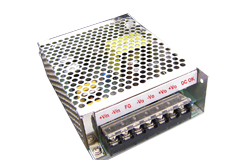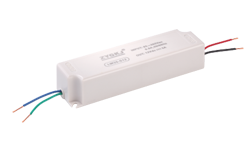ข่าว
Bidirectional DC DC Converter: Principles, Topologies, and Applications
Author: ZYG Power Module Time: 2023-6-24
A bidirectional DC-DC converter is a power electronic device that can transfer electrical energy bidirectionally between two DC voltage levels. It is widely used in various applications, including electric vehicles, renewable energy systems, and battery energy storage systems. This article will explore the principles, topologies, and applications of bidirectional DC-DC converters.
Principles of Bidirectional DC-DC Converter
The main function of a bidirectional DC-DC converter is to transfer power from one DC voltage level to another. The power transfer can be either unidirectional or bidirectional. A bidirectional converter can transfer energy from a high voltage source to a low voltage load and vice versa. Bidirectional DC-DC converters typically consist of two power converters, each with its own power switch and control circuit. One converter operates in the forward direction, transferring energy from the input voltage to the output voltage, while the other converter operates in the reverse direction, transferring energy from the output voltage to the input voltage.
The operation of a bidirectional converter is controlled by a feedback loop that adjusts the duty cycle of the power switches to maintain the desired output voltage level. The duty cycle determines the amount of time the power switch is on during each switching cycle. By adjusting the duty cycle, the output voltage can be regulated to a desired level.
Topologies of Bidirectional DC-DC Converter
There are several topologies of bidirectional DC-DC converters, including full-bridge, half-bridge, and interleaved. Each topology has its advantages and disadvantages, and the choice of topology depends on the specific application requirements.
The full-bridge bidirectional DC-DC converter is a popular topology used in high-power applications. It consists of four power switches arranged in a bridge configuration. In the forward direction, the input voltage is applied across the diagonal of the bridge, while the load is connected across the other diagonal. In the reverse direction, the input and output terminals are swapped, and the converter operates in the opposite direction.
The half-bridge bidirectional DC-DC converter is a simpler topology that uses two power switches. In the forward direction, the input voltage is applied across one switch, while the load is connected across the other switch. In the reverse direction, the input and output terminals are swapped, and the converter operates in the opposite direction.
The interleaved bidirectional DC-DC converter is a more complex topology that uses multiple power converters in parallel. This topology has the advantage of reducing the input and output current ripple and improving the overall efficiency.

Applications of Bidirectional DC-DC Converter
Bidirectional DC-DC converters are widely used in various applications, including electric vehicles, renewable energy systems, and battery energy storage systems. In electric vehicles, bidirectional converters are used to transfer energy between the battery pack and the vehicle\’s electrical system. The converter can charge the battery pack when the vehicle is braking or decelerating, and it can discharge the battery pack to power the vehicle\’s electrical system when accelerating.
In renewable energy systems, bidirectional converters are used to transfer energy between the DC voltage level of the renewable energy source, such as a solar panel or wind turbine, and the DC voltage level of the load or the battery storage system. The converter can also transfer energy from the battery storage system to the load when the renewable energy source is not available.
In battery energy storage systems, bidirectional converters are used to charge and discharge the battery pack. The converter can charge the battery pack when excess energy is available from the grid or a renewable energy source, and it can discharge the battery pack to supply power to the load when needed.
Conclusion
In summary, bidirectional DC-DC converters are important power electronic devices that can transfer energy bidirectionally between two DC voltage levels. They are widely used in various applications, including electric vehicles, renewable energy systems, and battery energy storage systems. The choice of topology depends on the specific application requirements, and the operation of the converter is controlled by a feedback loop that adjusts the duty cycle of the power switches to maintain the desired output voltage level.
ก่อนหน้า: ZP Series AC DC Converter – Efficient Power Conversion Solutions
ต่อไป: Medical Power Series: Empowering Healthcare Professionals and Patients for Better Health
ข้อมูลที่เกี่ยวข้อง
-
2023-7-13
Car Outlet Converter: Power Your Devices on the Go!
In today's fast-paced world, staying connected is more important than ever. Whether it’s for work or leisure, we rely heavily on our electronic devices to keep us informed, entertained, and productive. However, one of the biggest challenges we face is keeping our devices powered up, especially when we are on the go. Thankfully, with the introduction of car outlet converters, that challenge is now a thing of the past. A car outlet converter is a device that allows you to convert the DC power from your car’s cigarette lighter socket into AC power, which can then be used to power or charge your electronic devices. This small yet powerful gadget has revolutionized the way we use our devices while on...
ดูรายละเอียด -
2023-4-14
AC-DC Converter: A Guide to Understanding and Utilizing It
An AC-DC converter is an electronic device that converts alternating current (AC) to direct current (DC). This technology is commonly used in various electronic devices such as computers, televisions, and home appliances. The AC-DC converter works by taking the AC input voltage and using a rectifier to convert it to a DC voltage. The rectifier is usually a diode, which allows current to flow in only one direction. Once the voltage is rectified, it is then filtered through a capacitor to remove any remaining AC components. The final output voltage is then regulated to ensure that it remains constant and free from any fluctuations. There are two main types of AC-DC converters: linear and switching. Linear converters use a simple...
ดูรายละเอียด -
2022-5-16
จะมั่นใจในความปลอดภัยของสวิตช์ไฟเมื่อจัดการกับความผิดพลาดได้อย่างไร?
คุณรู้หรือไม่ว่าปัญหาใดที่ควรใส่ใจในกระบวนการจัดการกับความล้มเหลว? เพื่อให้ทุกคนปลอดภัย (1) เกือบตลอดเวลาในกระบวนการของความผิดพลาดในการประมวลผลการเหนี่ยวนำการทำงานจริง ดังนั้นเราต้องให้ความสนใจไม่สามารถทำให้เกิด DC เอาต์พุต การสื่อสาร AC อินพุตลัดวงจร เครื่องมือพิเศษในการบำรุงรักษาทุกชนิดต้องทำงานได้ดีในชั้นฉนวน การรักษาเพื่อความปลอดภัยของชีวิตและสวิตช์เครื่องจ่ายไฟอุปกรณ์จ่ายไฟความปลอดภัย (2) ในการใช้งานจริงจนถึงการทำงานด้วยมือเดียวให้มากที่สุด มือที่ใช้งานจริงไม่อนุญาตให้มีการตกแต่งตัวนำไฟฟ้าวัสดุโลหะ เช่น นาฬิกา กุญแจ แหวน ฯลฯ ร่วมกับรองเท้าฉนวนสำหรับ ..
ดูรายละเอียด -
2023-6-3
12V 15A AC to DC Converter: Transforming Alternating Current into Direct Current
In today's world, electricity is an essential part of our daily lives. We use it to power our homes, workplaces, and even our vehicles. However, the electrical power that we receive from the grid is in the form of alternating current (AC), which is not suitable for many devices that require direct current (DC) to operate. This is where a 12V 15A AC to DC converter comes in. As the name suggests, this device converts AC power into DC power, making it possible to power DC devices from an AC source. The process of converting AC power to DC power involves several stages. The first stage is rectification, which involves converting the AC signal into a pulsating DC signal. This...
ดูรายละเอียด -
2023-11-16
Module Power Supply: Meeting the Power Needs of Modern Technology
In today's rapidly advancing technological world, the demand for power is ever-increasing. From smartphones to laptops, from electric vehicles to data centers, each device requires a reliable and efficient power supply to function properly. This is where module power supply comes into play. Module power supply, also known as modular power supply, is a revolutionary solution that has been developed to meet the power needs of modern technology. So, what exactly is module power supply? It is a power supply system that consists of various modules, each responsible for delivering power to different components of a device or system. These modules can be connected or disconnected easily, allowing for flexibility and scalability. This modular approach enables users to customize their...
ดูรายละเอียด -
2023-11-30
AC/DC Power Supply Module: An Essential Component for Efficient Electrical Systems
In the rapidly evolving world of technology, the demand for efficient and reliable electrical systems is constantly increasing. Whether it's powering our homes, offices, or even the devices we use daily, electricity plays a crucial role in our lives. One of the essential components that enable efficient electrical systems is the AC/DC power supply module. The AC/DC power supply module serves as a bridge between the alternating current (AC) power supplied by the utility grid and the direct current (DC) power needed by electronic devices. It converts the high voltage AC power into low voltage DC power, ensuring a stable and regulated power supply to various electronic devices. One of the primary reasons why AC/DC power supply modules are vital...
ดูรายละเอียด


















